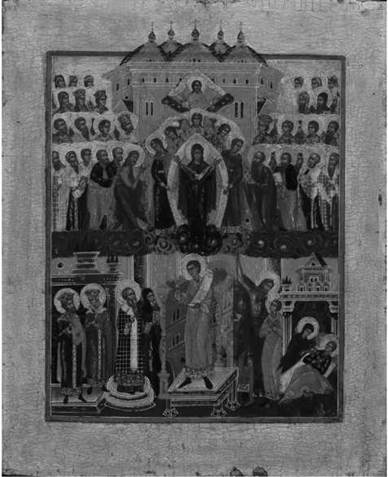Protecting Veil
VERA SHEVZOV
The Protecting Veil (Greek skepe, maphorion; Russian, Pokrov), celebrated on October 1, is one of the most beloved Marian feasts on the Orthodox calendar in Slavonic Orthodox lands. The inspiration for the feast was a 10th-century vision in the Church of the Virgin of Blachernae, Constantinople, by the Blessed Andrew, the Fool for Christ, as recorded by the presbyter Nicephoros. According to the tradition, the Mother of God spread her protective veil, which “radiated the glory of God,” over all those present in church. The celebration of the Protecting Veil thus recognizes the Theotokos as the universal heavenly protectress of all Christians. While there is scant evidence of any liturgical commemoration of this feast in Byzantium, it became immensely popular in Russia; whether developing from origins at Constantinople, Kiev, or Northern Russia remaining a point of controversy. By the end of the 19th century the feast was usually dated to the 12th century and was credited to the Grand Prince Andrei Bogoliubskii, who took St. Andrew as his patron saint. Liturgically, it parallels the feast of the Deposition of the Precious Robe of the Theotokos at Blachernae for July 2. The festal icon shows the central figure of the Mother of God spreading her protective veil, Blessed Andrew pointing her out to his disciple Epiphanius, St. John the Forerunner (who in Andrew’s vision accompanied Mary into the Blachernae church), and St. Romanos the Melodist (whose commemoration also occurs on October 1).

Plate 51 Icon of the Protecting Veil depicting the Holy Fool Andrew. Photo Temple Gallery, London.
SEE ALSO: Fools, Holy; Theotokos, the Blessed Virgin
REFERENCES AND SUGGESTED READINGS
Lyden, L. (1976) “The Vision of the Virgin at Blachernae and the Feast of the Pokrov,” Analecta Bollandiana 94: 63–82.
Presbyter Nicephorus (1976) “Life of Andrew, the Fool for Christ,” in J. P. Migne (ed.) Patrologiae Graecae, Vol. 111. Turnhout, Belgium: Brepols, cols. 620–887.
